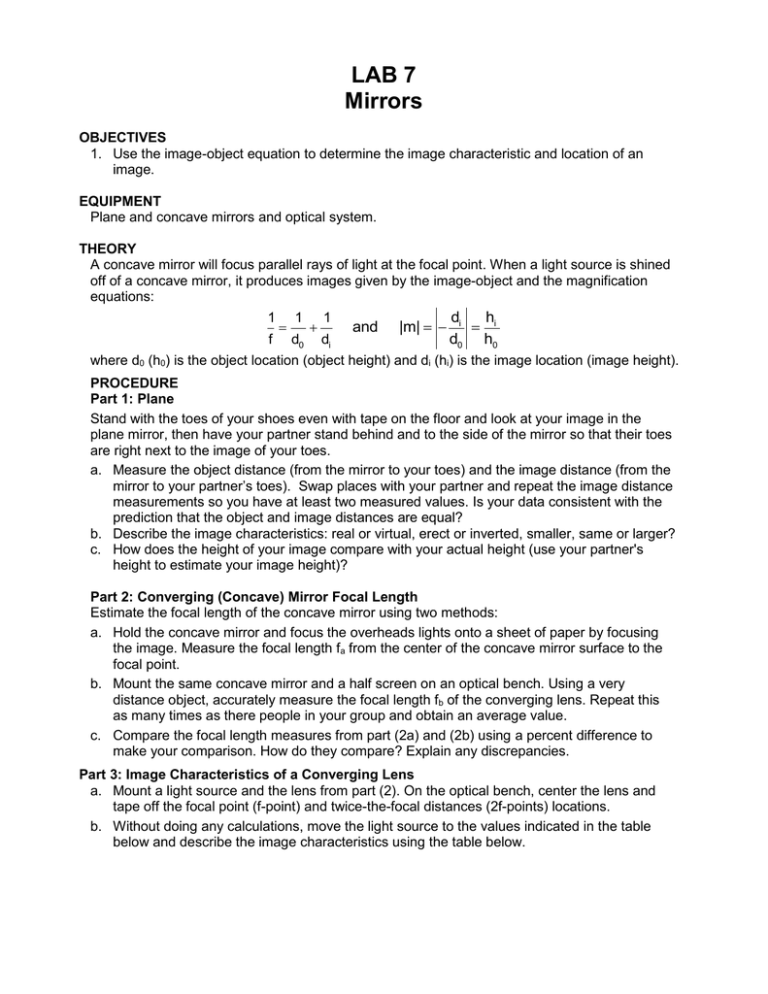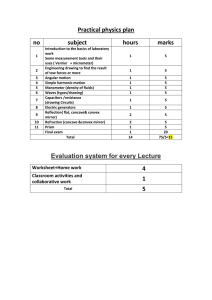LAB 7 Mirrors
advertisement

LAB 7 Mirrors OBJECTIVES 1. Use the image-object equation to determine the image characteristic and location of an image. EQUIPMENT Plane and concave mirrors and optical system. THEORY A concave mirror will focus parallel rays of light at the focal point. When a light source is shined off of a concave mirror, it produces images given by the image-object and the magnification equations: 1 1 1 and |m| di h i d0 h0 f d0 di where d0 (h0) is the object location (object height) and di (hi) is the image location (image height). PROCEDURE Part 1: Plane Stand with the toes of your shoes even with tape on the floor and look at your image in the plane mirror, then have your partner stand behind and to the side of the mirror so that their toes are right next to the image of your toes. a. Measure the object distance (from the mirror to your toes) and the image distance (from the mirror to your partner’s toes). Swap places with your partner and repeat the image distance measurements so you have at least two measured values. Is your data consistent with the prediction that the object and image distances are equal? b. Describe the image characteristics: real or virtual, erect or inverted, smaller, same or larger? c. How does the height of your image compare with your actual height (use your partner's height to estimate your image height)? Part 2: Converging (Concave) Mirror Focal Length Estimate the focal length of the concave mirror using two methods: a. Hold the concave mirror and focus the overheads lights onto a sheet of paper by focusing the image. Measure the focal length fa from the center of the concave mirror surface to the focal point. b. Mount the same concave mirror and a half screen on an optical bench. Using a very distance object, accurately measure the focal length fb of the converging lens. Repeat this as many times as there people in your group and obtain an average value. c. Compare the focal length measures from part (2a) and (2b) using a percent difference to make your comparison. How do they compare? Explain any discrepancies. Part 3: Image Characteristics of a Converging Lens a. Mount a light source and the lens from part (2). On the optical bench, center the lens and tape off the focal point (f-point) and twice-the-focal distances (2f-points) locations. b. Without doing any calculations, move the light source to the values indicated in the table below and describe the image characteristics using the table below. f 2f d0 Real/Virtual Inverted/Erect Size d0 > 2f d0 = 2f 2f > d0 > f d0 < f d. Now mount the light source at one end of the optical bench and place the concave mirror a distance outside the 2f-point from the light source. e. Using the image-object equation, predict the image distance di,thy and the image height hi,thy. f. Use a screen to find the image location di,exp and image height hi,exp. Compare di,thy & di,exp and hi,thy & hi,exp using a percent difference. How do they compare? g. Keeping the light source at one end of the optical bench and adjusting the mirror distance from the light source, repeat steps (3c – 3e) for object distances of 40 cm, 2f & 20 cm. f(cm) d0(cm) di,thy (cm) di,exp (cm) % hi,thy (cm) hi,exp (cm) % 40 cm 2f 20 Part 4: Telescope Explain how the telescope works by explaining the role of the mirror and the magnifier.


